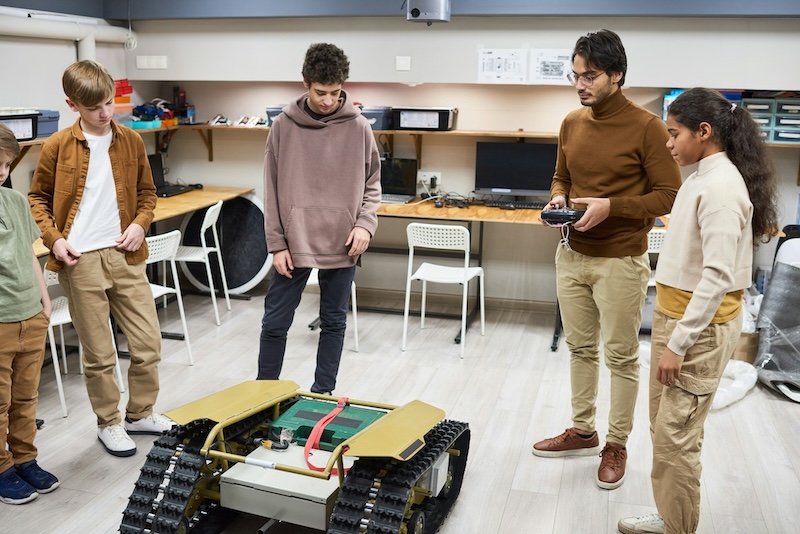Branded Content by Cosmic Press
Key Takeaways
- AI in education is transforming the way we teach, learn, and interact in learning spaces.
- Personalized learning adjusts to the pace and requirements of each student, enhancing engagement and achievement.
- AI tutors offer 24/7 learning assistance, particularly beneficial for independent and distance learners.
- Education machine learning provides teachers with immediate feedback to make more effective teaching choices.
- Accessibility is enhanced for disabled learners or language learners by AI-enabled tools.
- Human supervision and ethical AI usage guarantee the long-term positive effect of AI in education.
Education is being revolutionized, and at its core lies artificial intelligence (AI). AI in education is making classroom life better and changing how students learn at a pace never before seen.
As of 2023, the global AI in education market stood at USD 4 billion and is anticipated to expand to USD 20 billion by 2027 with a CAGR of 45%.
AI is no longer something from the future—it is an operational, working part of learning systems all over the world right now. As institutions, schools, and universities embrace digital innovation, AI-driven education is becoming a positive answer to traditional challenges. For researchers, instructors, students, and EdTech professionals, knowing about this shift is essential in realizing the future of learning.
Why AI Is Important in Today’s Classrooms
Traditional education models often lag in responding to new requirements of diverse student populations. The one-size-fits-all approach can potentially leave behind hundreds of students who either need special help or differentiated learning. That is where AI-powered learning comes in with a scalable solution to individualize learning and improve performance.
With intelligent algorithms and real-time information, AI is capable of making the teaching philosophy and curriculum specifically tailored to fit the student learner’s pace and requirements.
It not only improves engagement but facilitates every student being able to benefit from the kind of assistance necessary for them to excel.
According to McKinsey & Company, AI-driven teaching may release teachers by up to 13 hours per week, allowing them to devote more time to tasks directly linked to student learning and accomplishment.
Personalized and Adaptive Learning: One Size No Longer Fits All
Personalized learning is quite possibly the biggest advance AI has made in the education space. Personalized learning uses AI to analyze the behavior of the students, performance trends, and even learning style to create tailored learning paths.
A UNESCO report in 2023 confirmed that AI personalized systems improved the learning outcomes of students by up to 20%, specifically for low-achieving primary and secondary school students.
This ensures students learn at their pace, review trouble spots, and skip what they already understand.
Adaptive learning platforms can even adjust difficulty levels in real-time to ensure that the learners are challenged but not stumped. This form of flexibility leads to better retention, higher motivation, and enhanced overall academic success.
AI Tutors and Virtual Assistants: Academic Support 24/7, Anywhere
The demand for 24/7 academic support has grown, especially in online and hybrid learning environments. AI tutors are stepping in to meet this demand, offering live support to students outside of scheduled class time.
According to HolonIQ, over 65% of higher education institutions globally have implemented or plan to implement AI-powered tutoring or learning assistance tools by 2025. These computer programs are able to respond to questions, clarify tough concepts, and lead students through quizzes or assignments.
Through natural language processing, many AI tutors also engage conversationally, simulating one-on-one tutor interaction. This round-the-clock availability is particularly useful for students who might lack access to human tutors or prefer learning at their own pace.
Brookings Institution studies have shown that such tools not only boost engagement but also reduce teachers’ workload, thereby making them a win-win solution.
AI and Student Engagement: Making Learning Stick
Keeping students engaged has never been a straightforward task—especially in online settings or courses with big numbers.
Educational AI is making this challenge more manageable with the application of interactive technologies such as gamified learning materials, smart feedback, and adaptive learning interfaces. These systems monitor how students respond to material and adjust the experience to keep them interested.
For example, if a student is lagging or appears lost, the system might give positive feedback, simplify the work, or show in a new display to bring the focus back. In doing so, students are able to maintain focus longer, learn more, and often exhibit greater interest in learning.
Data-Driven Support for Educators
While students acquire improved content, teachers get an even richer sense of their students through machine learning in education. Computers are able to collect huge amounts of information—from test scores to attendance numbers—to provide teachers with valuable insights into student performance. This allows teachers to identify where students are making mistakes early on, adapt their approach to instruction accordingly, and track class-wide progress with much greater precision. Instead of spending hours poring over assignments or making guesses about which students are struggling, teachers can immediately and effectively respond through real-time data. Such discoveries ultimately make instruction more accurate and learning outcomes better.
Enhancing Learning Accessibility and Inclusion
Accessibility is one of the areas where AI is making an enormous difference. Students with disabilities or language barriers tend to find insurmountable obstacles in regular classrooms.
Artificial intelligence in education technologies such as speech-to-text, live captioning, and language translation software remove these barriers and allow equal access to learning.
For example, AI can live caption a lecture or provide plain-language abstracts of complex text for students with additional needs. By doing so, AI-facilitated learning allows all learners—no matter their background—to participate meaningfully in learning. According to the National Center for Education Statistics, over 7 million students in the U.S. receive special education services, and AI tools are increasingly being used to personalize support and improve access for these learners.
Ethical Use: What We Must Get Right
With great power, there must be great responsibility. The more education facilities employ AI, the more there are concerns related to privacy, bias, and transparency of the algorithms. Privacy protection laws should be respected, and developers have to make the AI systems impartial and inclusive towards all users.
It is equally essential to identify that AI would complement, but not substitute for, human educators. Though machines can perform many tasks well, the emotional intelligence and guidance that teachers provide are still invaluable aspects of a good education.
Final Thoughts
Artificial Intelligence in education is no longer a science fiction phenomenon—it’s already a groundbreaking technology reshaping how we learn and teach. With shifting education challenges, AI introduces real, scalable solutions to improving learning as more efficient, inclusive, and personalized. From AI tutors to adaptive learning systems, AI-powered tools are empowering students to reach their potential and educators to make more effective decisions. But deliberate deployment, with equity and ethics leading the way, is essential to ensuring AI for all. Moving forward, embracing AI-powered education will be the most important move toward building a wiser, more networked, and forward-thinking education system.
Frequently Asked Questions
1. What is AI in education?
Education AI is the application of artificial intelligence technologies—such as machine learning, natural language processing, and predictive analytics—to enhance the learning experience and academic administration.
2. In what ways does AI enable individual learning?
AI scans student behavior and performance to craft customized learning pathways, providing the right material at the right time in the right format.
3. Is it possible for AI to replace human teachers?
No. AI may perform numerous assistive functions but cannot offer the emotional connection, guidance, or rational insight human teachers bring into the learning environment.
4. Is AI secure to implement within schools?
Yes, if responsibly done. Institutions must use secure platforms, comply with data protection regulations, and exercise transparency in AI decision-making.
5. Where can students find reliable academic support on AI?
Students can ask AI Studocu, which offers AI-based help with study questions under the supervision of expert knowledge.
Branded content furnished by our promotional partners. The Daily Sundial editorial staff is not involved in its production. Content does not reflect the views or opinions of the editorial staff.








